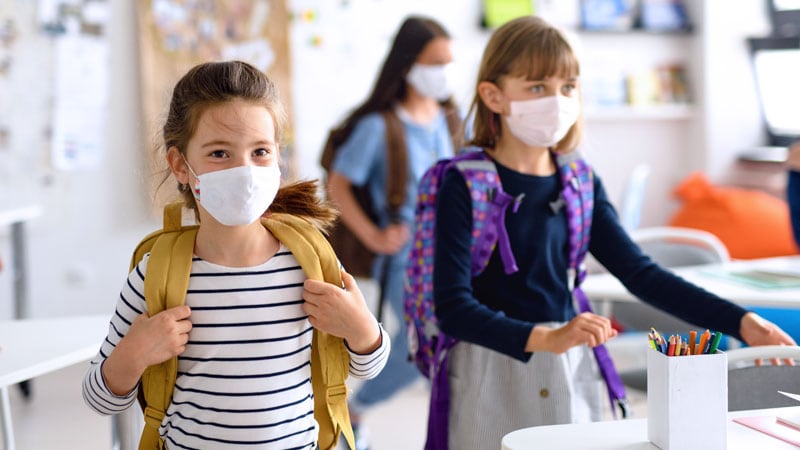The school setting is an important site of SARS-CoV-2 transmission, new data suggest.
An analysis of surveillance data for almost 1000 exposures to SARS-CoV-2 found that students accounted for a higher proportion of infected individuals who caused onward transmission than did the public overall (46.2% vs 25%).
“Our analysis suggests that younger age groups were deeply involved in the spread of the infection,” wrote study author Stefano Merler, MSc, a fellow at the Bruno Kessler Foundation in Trento, Italy, and his coauthors. They added that “control programs targeting contexts responsible for most of the transmission could be effective in limiting the spread of the infection, including in educational settings.”
The data were published online Sept. 20 in Influenza and Other Respiratory Viruses.
Outbreak in Italy
The researchers examined data from surveillance and extensive screening during a SARS-CoV-2 outbreak in Mede, Italy, between Jan. 7 and March 10, 2021. They identified 460 positive individuals and 976 SARS-CoV-2 exposure events. When they removed cases and case contacts that were associated with unclear infection episodes, 297 SARS-CoV-2 infections and 584 exposure events remained in their analysis.
In all, 209 individuals (70.4%) did not cause any secondary infection. The average number of secondary cases caused by a positive individual was 0.51.
Among students, however, there was a higher proportion of individuals who caused onward transmission than in the overall population (46.2% vs 25.0%). The average number of secondary cases caused by a positive student was 1.03.
Overall, infections represented 30.5% of exposures in the household, 25.9% of exposures in the community, and 19.4% of exposures in school. After adjustment for possible confounders such as age, however, the risk of infection was not statistically different between settings, the investigators reported.
Using an age-specific matrix, the researchers calculated the average number of infections caused by a positive case in each age group. The highest transmission intensity was from young children to adults and between children of similar age, “possibly reflecting contacts between siblings or schoolmates,” they wrote.
In addition, SARS-CoV-2 transmission between schoolmates was associated with longer transmission chains. On average, positive students named 5.0 contacts, compared with 1.5 contacts for other individuals. The researchers also estimated a larger number of infections for clusters originating in school-related exposures, compared with other clusters.
“This implies that uncontrolled transmission in the student population could disrupt the regular conduct of teaching activities and lead to a harsh burden for contact-tracing operations at the same time,” wrote the investigators. “In addition, the circulation of SARS-CoV-2 in the scholastic population may entail a high risk of importation of the infection into a large set of households from where it can reach age segments at higher risk of infection and disease.”
Interpretation Requires Caution
Commenting on the study for Medscape, Athena Kourtis, MD, PhD, MPH, a clinical professor of pediatrics at Emory University in Atlanta, Georgia, said that the results “confirm that children can spread the infection to others, whether at home or in a school setting.” Kourtis was not involved in the research.
The findings should be interpreted with some caution, however. “In these types of investigations, one can never be certain that the transmission occurred at the school or outside the school, and we cannot be sure that all contacts were identified or were actually tested,” said Kourtis. “Also, testing and screening efforts depended on the public health and the clinical care efforts and were not part of a controlled research experiment, so it is possible that some groups of people had different access to (or acceptance of) testing than others, which can introduce bias in the results.”
The timing of the study also must be considered. The data “refer to the first months of 2021, when the alpha variant was emerging in Italy and vaccination efforts were just starting. There may be differences with the current state of the epidemic, when different variants predominate, and vaccination is more widespread,” said Kourtis. “Vaccination of all eligible individuals in schools is the single best strategy to protect students and staff from severe disease, hospitalization, and death and to maintain in-person learning,” she added.
Kourtis is a member of the American Academy of Pediatrics Committee on Infectious Diseases. In its recently released “COVID-19 Guidance for Safe Schools and Promotion of In-Person Learning,” the AAP held that “schools do not significantly increase community transmission, especially when guidance outlined by the World Health Organization, United Nations Children’s Fund, and Centers for Disease Control and Prevention is followed.” It outlined steps that are needed to keep children and adolescents safely in schools during the pandemic.
The study was supported by European Commission Horizon 2020. One author has received research funding from Seqirus. The funding is not related to COVID-19. All other authors declare no competing interests. Kourtis declared no competing interests.
Influenza Other Respir Viruses. Published online Sept. 20, 2022. Full text.
Kate Johnson is a Montreal-based freelance medical journalist who has been writing for more than 30 years about all areas of medicine.
For more news, follow Medscape on Facebook, Twitter, Instagram, and YouTube.
Source: Read Full Article
